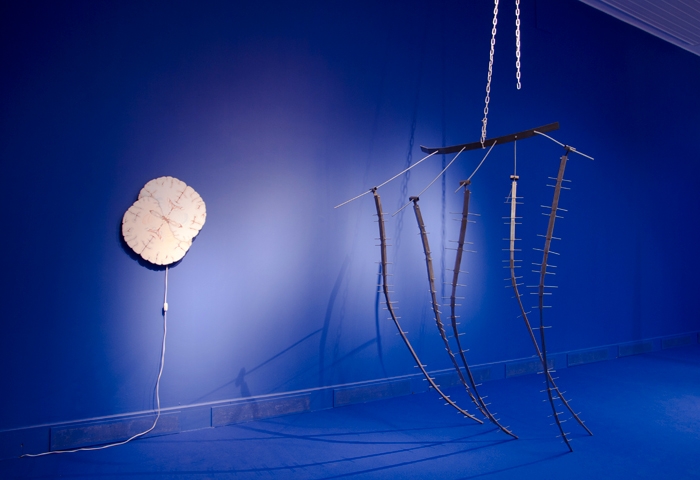As I fly out of Norrbotten, Sweden’s arctic region, I sit amid rows of soldiers. Luleå, the port city from which we departed, is located 900km north of Stockholm and provides access to a military site known as the Vidsel Test Range. Once iron and timber, this region’s natural resource is now its emptiness: its nature reserve is rented out for bomb testing. I’m the odd one out, having been here for the Luleå Biennial, which was set up in 1991 by a local art collective, the Kilen Art Group, and has now been taken over by three young curators, Emily Fahlén, Asrin Haidari and Thomas Hämén. The set of exhibitions, showing work by 37 artists, begins in Luleå, occupying unlikely venues – from a Cold War bunker to a crane at the old harbour – and expands into the regional towns of Jokkmokk, Boden and Kiruna, the last a five-hour bus ride north into the Arctic Circle. Titled Tidal Ground, the biennale is themed around darkness. At the beginning of the winter season, when the days are less than six hours long, a golden sun streaks along the horizon, seeming continually to be setting.
At the Luleå Konsthall, a cultural centre on the seafront, familiar works such as Francis Alÿs’s film Paradox of Praxis 5 (2013), which documents a burning soccer ball as it is kicked through the streets of Ciudad Juárez by night, are placed alongside regional art. Sami artist Britta Marakatt-Labba has embroidered a flour sack left in the Arctic by German soldiers during the Second World War, which is displayed framed beside a Sami wartime passport. MarakattLabba’s father was a reindeer herder and Sami – one of the indigenous people of the northerly region of Sweden, Norway, Finland and Russia – who witnessed the Nazi occupation of Norway during the 1940s. The sack is embroidered with a reindeer, a postage stamp and a gun. As these artefacts attest, the militarisation of the northern borders prevented nomadic herders from travelling through their lands, a cultural region known as Sápmi. Punctuating the exhibition, meanwhile, are sculptures by Norwegian artist Hanni Kamaly, anthropomorphic assemblages of steel rods that droop and dangle like limbs. In Freddie Gray (2016), named after the African-American man who died in Baltimore police custody in 2015, five steel legs are held in a metal harness, a trapped figure that resembles both the architecture of confinement and the incarcerated body. Kamaly’s sculptures illustrate degradation, turning humans into things – a ‘thingification’ that softens the ground for transgression, be it of indigenous or civil rights.
Throughout the first half of the twentieth century, a chain of fortresses and defence facilities were built across the Norrbotten borderland, preparations for a war that never came. One example is Mjölkuddsberget, a hill on the outskirts of Luleå tunnelled out during the Cold War. Decommissioned in 2000, Milk Point Mountain is now privately owned, its dank bunkers deployed as a mushroom farm and bitcoin mine. Raqs Media Collective’s The Blood of Stars (2017) takes over freezing shafts and caverns, which I roam with a handheld torch. Telephones ring in cold, empty rooms while spotlights range over the ghostly concrete chambers.
Across town, in a small group show at the artist-run Galleri Syster, most compelling are the pearly sculptures by Kuwaiti artist Monira Al Qadiri that make up Spectrum I (2016). Displayed along a wall and shellacked glossy, glittery pinks, the cone-shaped objects look like futuristic telephones, or perhaps sex toys. I soon learn they are 3d models of drill heads – tools of extreme destruction, used to bore holes into the earth’s crust.
A two-hour bus ride north is the town of Jokkmokk, home to the Ájtte Museum, established in 1989 by the Sami community to tell the story of their people. Here, works by seven artists have been integrated among the exhibits of Sami furs and shamanic drums. In one room, Hiwa K’s Pre-Image (Blind as the Mother Tongue) (2017) plays on a television set, following the artist as he retraces his 1996 journey from Kurdistan to Europe, balancing a dizzying sculpture made of mirrors on his nose; in another room, a mirror work by Swedish artist Lap-See Lam reflects back Sami artefacts. It’s a subtle intervention – like the biennale itself – one that draws attention to what is here already, reminding viewers that this landscape is anything but empty.
Luleå Biennial, various venues, Norrbotten, 17 November 2018 – 17 February 2019
From the January & February 2019 issue of ArtReview
